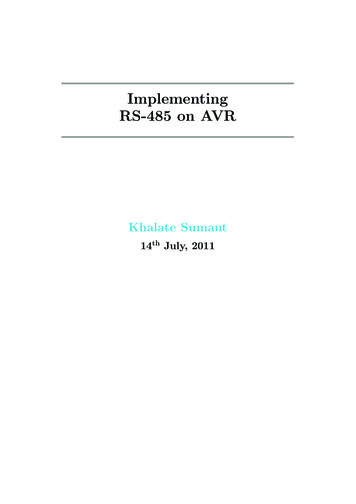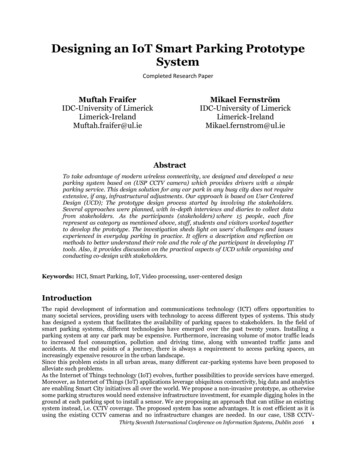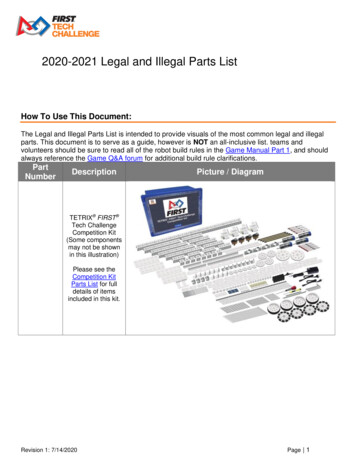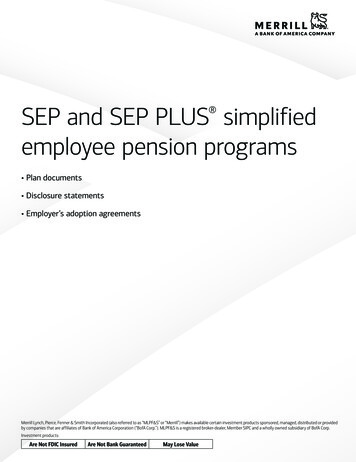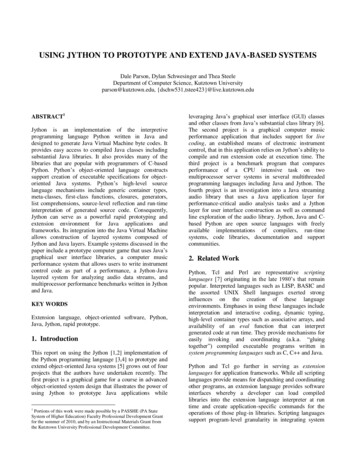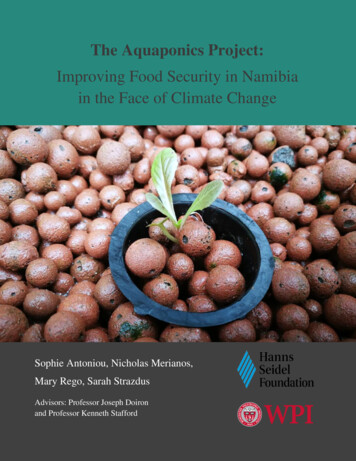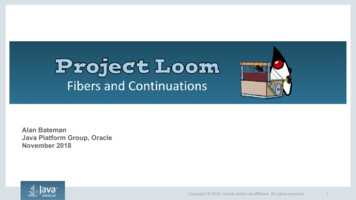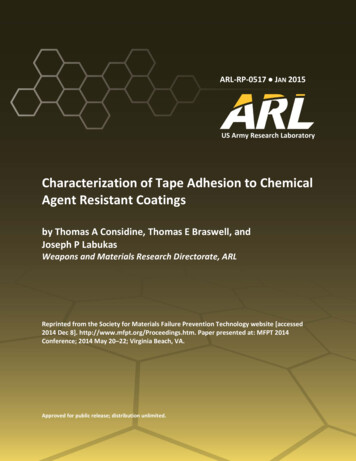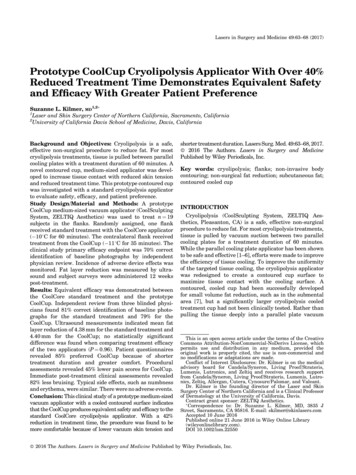
Transcription
Lasers in Surgery and Medicine 49:63–68 (2017)Prototype CoolCup Cryolipolysis Applicator With Over 40%Reduced Treatment Time Demonstrates Equivalent Safetyand Efficacy With Greater Patient PreferenceSuzanne L. Kilmer, MD1,2 Laser and Skin Surgery Center of Northern California, Sacramento, California2University of California Davis School of Medicine, Davis, California1Background and Objectives: Cryolipolysis is a safe,effective non-surgical procedure to reduce fat. For mostcryolipolysis treatments, tissue is pulled between parallelcooling plates with a treatment duration of 60 minutes. Anovel contoured cup, medium-sized applicator was developed to increase tissue contact with reduced skin tensionand reduced treatment time. This prototype contoured cupwas investigated with a standard cryolipolysis applicatorto evaluate safety, efficacy, and patient preference.Study Design/Material and Methods: A prototypeCoolCup medium-sized vacuum applicator (CoolSculptingSystem, ZELTIQ Aesthetics) was used to treat n ¼ 19subjects in the flanks. Randomly assigned, one flankreceived standard treatment with the CoolCore applicator( 108C for 60 minutes). The contralateral flank receivedtreatment from the CoolCup ( 118C for 35 minutes). Theclinical study primary efficacy endpoint was 70% correctidentification of baseline photographs by independentphysician review. Incidence of adverse device effects wasmonitored. Fat layer reduction was measured by ultrasound and subject surveys were administered 12 weekspost-treatment.Results: Equivalent efficacy was demonstrated betweenthe CoolCore standard treatment and the prototypeCoolCup. Independent review from three blinded physicians found 81% correct identification of baseline photographs for the standard treatment and 79% for theCoolCup. Ultrasound measurements indicated mean fatlayer reduction of 4.38 mm for the standard treatment and4.40 mm for the CoolCup; no statistically significantdifference was found when comparing treatment efficacyof the two applicators (P ¼ 0.96). Patient questionnairesrevealed 85% preferred CoolCup because of shortertreatment duration and greater comfort. Proceduralassessments revealed 45% lower pain scores for CoolCup.Immediate post-treatment clinical assessments revealed82% less bruising. Typical side effects, such as numbnessand erythema, were similar. There were no adverse events.Conclusion: This clinical study of a prototype medium-sizedvacuum applicator with a cooled contoured surface indicatesthat the CoolCup produces equivalent safety and efficacy to thestandard CoolCore cryolipolysis applicator. With a 42%reduction in treatment time, the procedure was found to bemore comfortable because of lower vacuum skin tension andshorter treatment duration. Lasers Surg. Med. 49:63–68, 2017.ß 2016 The Authors. Lasers in Surgery and MedicinePublished by Wiley Periodicals, Inc.Key words: cryolipolysis; flanks; non-invasive bodycontouring; non-surgical fat reduction; subcutaneous fat;contoured cooled cupINTRODUCTIONCryolipolysis (CoolSculpting System, ZELTIQ Aesthetics, Pleasanton, CA) is a safe, effective non-surgicalprocedure to reduce fat. For most cryolipolysis treatments,tissue is pulled by vacuum suction between two parallelcooling plates for a treatment duration of 60 minutes.While the parallel cooling plate applicator has been shownto be safe and effective [1–6], efforts were made to improvethe efficiency of tissue cooling. To improve the uniformityof the targeted tissue cooling, the cryolipolysis applicatorwas redesigned to create a contoured cup surface tomaximize tissue contact with the cooling surface. Acontoured, cooled cup had been successfully developedfor small volume fat reduction, such as in the submentalarea [7], but a significantly larger cryolipolysis cooledtreatment cup had not been clinically tested. Rather thanpulling the tissue deeply into a parallel plate vacuumThis is an open access article under the terms of the CreativeCommons Attribution-NonCommercial-NoDerivs License, whichpermits use and distribution in any medium, provided theoriginal work is properly cited, the use is non-commercial andno modifications or adaptations are made.Conflict of Interest Disclosures: Dr. Kilmer is on the medicaladvisory board for Candela/Syneron, Living Proof/Strateris,Lumenis, Lutronics, and Zeltiq and receives research supportfrom Candela/Syneron, Living Proof/Strateris, Lumenis, Lutronics, Zeltiq, Allergan, Cutera, Cynosure/Palomar, and Valeant.Dr. Kilmer is the founding director of the Laser and SkinSurgery Center of Northern California and is a Clinical Professorof Dermatology at the University of California, Davis.Contract grant sponsor: ZELTIQ Aesthetics. Correspondence to: Dr. Suzanne L. Kilmer, MD, 3835 JStreet, Sacramento, CA 95816. E-mail: skilmer@skinlasers.comAccepted 10 June 2016Published online 21 June 2016 in Wiley Online Library(wileyonlinelibrary.com).DOI 10.1002/lsm.22550ß 2016 The Authors. Lasers in Surgery and Medicine Published by Wiley Periodicals, Inc.
64KILMERFig. 1. The CoolCup prototype device was created by modifying a commercially-available CoolCoreparallel plate cryolipolysis vacuum applicator (a) with a machined metal insert (b) to provide fullcooling surface contact to the sides and top of the tissue drawn into the cooling cup (c).applicator, the tissue was drawn gently into the cooled cup,allowing it to seat fully against the entire cup surface.In addition to improving cooling efficiency by increasingdirect tissue contact with the cooled surface, the coolingsurface was set to a lower temperature in order to reducethe overall procedure time. While current parallel platevacuum cryolipolysis commercial treatments are deliveredat 108C for 60 minutes, lower temperature treatmentshave been investigated and shown to be safe andefficacious. A prior study of flank treatments using acommercially-available parallel plate vacuum cryolipolysis applicator demonstrated safety and efficacy withparameters of 158C for 45 minutes [8]. Those studyresults were submitted for FDA clearance of lowertemperature cryolipolysis treatments. Currently, thereare two commercially-available cryolipolysis applicatorsthat deliver at temperatures lower than the typical 108C.The non-vacuum surface applicator (CoolSmooth PRO)delivers treatment to areas such as the lateral thighs at 138C for 75 minutes while the small volume cupapplicator (CoolMini) delivers treatment to sites such asthe submental area at 118C for 45 minutes [9].A novel contoured cup, medium-sized applicator wasdeveloped to increase tissue contact with reduced skintension and reduced treatment time. Based upon computational modeling, the treatment parameters for theprototype applicator were developed. A multilayer,three-dimensional finite element model of transient heatconduction was created to predict the subcutaneousfat temperature profile resulting from cryolipolysis treatment with the parallel plate and contoured cup applicators.Based upon the theoretical model, the cooling surface for aprototype medium volume cup vacuum applicator was setto 118C for 35 minutes to achieve similar tissuetemperature to the current parallel plate vacuum applicators set to 108C for 60 minutes. This prototypecontoured cup was investigated with a standard cryolipolysis applicator to evaluate safety, efficacy, and patientpreference.MATERIALS AND METHODSThis was a prospective, open label, interventional cohortstudy. The bilateral treatment study compared the prototypeapplicator to a standard parallel cooling plate applicator. Theprototype device was created by modifying a commerciallyavailable parallel plate cryolipolysis vacuum applicator. Amachined metal insert was installed in the standardapplicator to create a cooled, contoured cup surface (Fig. 1).Each subject received one treatment cycle on each flankconsisting of either a 108C, 60 minute cooling cycledelivered with the standard parallel cooling plate vacuumapplicator (CoolCore) or a 118C, 35 minute cooling cycledelivered using a prototype medium volume contouredcooled cup vacuum applicator (CoolCup). The standard andFig. 2. Comparison of immediate post-treatment IR thermography images show uniform coolingfrom the CoolCup (a) and localized cooling around the parallel plates for the CoolCore (b). SubjectKIL-016.
PROTOTYPE COOLCUP CRYOLIPOLYSIS APPLICATOR65Fig. 3. Comparison of immediate post-treatment photographs showing firm “butter stick”treatment areas from both applicators. No bruising is evident from the CoolCup (a), whereasbruising was observed for the CoolCore (b). Subject KIL-010.prototype applicator treatments were randomly assigned toeach subject’s left or right flank.Eligible subjects were male or female, between 22 and65 years of age, and with clearly visible subcutaneous flankfat and Body Mass Index (BMI) up to 30. For the duration ofthe study, subjects were instructed to avoid implementingmajor diet or exercise routine changes in order to maintaintheir weight within 5% of baseline measurement.The primary safety endpoint was defined by monitoringthe incidence of device- and/or procedure-related adverseevents. Immediately following treatment and at the 4- and12-week follow-up visits, clinical assessments were performed to evaluate the treatment areas. One week posttreatment, subjects were also contacted by telephone toassess the condition of the treatment areas. Safety wasmonitored by documentation of adverse events and clinicalassessment of the treatment site. Subjects were assessedthroughout the study for adverse events. Subject satisfaction data was collected by a written questionnaire at the12-week post-treatment visit.The efficacy endpoint was defined as 70% or greatercorrect identification of the pre-treatment images by threeblinded, independent physician reviewers. Photos weretaken at pre-treatment and 12-week post-treatment visits.At the baseline and follow-up visits, photographs wereacquired using a standardized photography set-up (NikonD810, Nikon 85 mm lens, DynaLite strobes) to ensureconsistency. Study subjects were positioned with their feetseparated at a fixed distance using a foot positioning guideand instructed to keep their arms raised and crossed atchest level. Clothing was carefully rearranged to reveal theflank treatment area with shirts raised and pinned out ofthe way and shorts lowered to avoid squeezing the flankarea and inadvertently modifying the appearance ofsubcutaneous fat. At the post-treatment visit, the photographer referred to baseline photographs while capturingthe follow-up photographs to ensure consistency in subjectpositioning and exposure. Subsequently, photos takenat the 12-week post-treatment visit were compared withthose taken at baseline by a blinded independent panel ofthree physicians board-certified in either dermatology orplastic surgery. Independent photo review data wasgenerated by randomizing pre-treatment and posttreatment photograph pairs of each subject, then askingthe reviewers to determine which image was the pretreatment image.Ultrasound images were acquired at baseline and 12week post-treatment visits. Flank ultrasounds wereobtained with subjects standing with crossed arms andstraight posture. Ultrasound areas were marked startingat the midpoint of the treatment area with one additionalultrasound area marked 2.5 cm on either side of the centralsite, for a total of three ultrasound measurements perflank. A transparent film was applied to each flank to markthe measurement areas and any landmarks (e.g., molesand scars) to facilitate locating the same ultrasound sitesin the follow-up visit. Measurements were conducted byplacing the transducer (model L38, bandwidth 10–5 MHz,SonoSite Inc., Bothell, WA) over the flank measurementsite and capturing the image on an ultrasound device(SonoSite Titan) to a depth of 3.9 cm. Care was taken toavoid adding pressure or negative pressure duringmeasurement. During the follow-up visit, subjects werepositioned in the same manner as at baseline. TheFig. 4. Baseline (a) and 12 week post-treatment (b) photos for a 59-year-old female. The left flankwas treated with the CoolCup for 35 minutes and the right flank was treated with the standardCoolCore for 60 minutes. Weight change 1.6 lbs. ( 1.2%) from baseline. Subject KIL-013.
66KILMERFig. 5. Baseline (a) and 12 week post-treatment (b) photos for a 41-year-old female. The left flankwas treated with the CoolCup for 35 minutes and the right flank was treated with the standardCoolCore for 60 minutes. Weight change 2.8 lbs. ( 1.7%) from baseline. Subject KIL-015.transparent film was applied and matched to the landmarks on the skin; ultrasound sites were marked on theskin and post-treatment images were captured. Ultrasound images were post-processed to measure anatomicalfeatures in the pre-treatment and post-treatment imagesand the fat layer reduction in the treatment area wascalculated.The cryolipolysis flank treatment was similar for bothapplicators. A protective gelpad was applied to the skin,either the standard CoolCore or prototype CoolCupapplicator was positioned over the flank, and vacuumsuction was initiated. The vacuum adhered the applicatorto the treatment area and the subject was seated on thetreatment table throughout the cryolipolysis treatment. Atthe conclusion of the treatment cycle, the applicator wasremoved, revealing firm, frozen tissue. Immediatelyfollowing removal of the applicator, infrared (IR) thermography images (FLIR Systems, Wilsonville, OR) wereobtained to evaluate the thermal profile across thetreatment areas. The contralateral flank was then treatedusing the other applicator.RESULTSNineteen patients were enrolled and completed treatment. The subject ages ranged from 33 to 59, with mean46.7 years. Weight ranged from 128.2 to 215.0 lbs, withmean 157.0 lbs. Body Mass Index (BMI) ranged from 21.0to 30.0, with mean BMI 25.2. All subjects remained withinthe allowed 5% weight change limit; therefore, no subjectswere excluded from treatment efficacy analysis due toweight change. The mean weight change between baselineand the 12 week follow-up visit was 0.5%. Seventeen ofthe subjects enrolled in the study were female and twowere male. The Fitzpatrick Skin Type of the subjectsranged from II to IV, with 58% Type II, 26% Type III, and16% Type IV. Ethnicity of the study subjects was 84%Caucasian and 16% Hispanic.Immediate post-treatment photos are shown in Figures 2and 3 with the subjects still seated following removal of theapplicators. As shown by the IR images obtained immediately following applicator removal, the CoolCup applicatorproduced a uniform cooling profile since the entire surfacearea of the treated flank was in contact with the contouredcooling cup. For the standard CoolCore treatment, discretelocalized cooling was observed on the sides of the treatedflank which were in direct contact with the cooling plates.The post-treatment images in Figure 3 show that bothapplicators produced firm, solidified “butter stick” tissue,but there was less bruising produced by the prototypeCoolCup.Figures 4–6 show representative subjects at baselineand 12 weeks post-treatment. Visible reduction in flankvolume is demonstrated from the pre- and post-treatmentphotographs. The standard CoolCore and prototypeCoolCup applicators produced similar fat reduction, asshown by clinical photographs. From the independentphoto review, three blinded, independent physiciansreviewed the 19 subjects’ photographs in randomizedpairs. For the standard CoolCore flank treatments, thereviewers correctly identified 81% (46/57), whereas for theprototype CoolCup flank treatments, the reviewers correctly identified 79% (45/57). The primary efficacy endpoint of at least 70% correct identification of the pretreatment images was met for both applicators.Ultrasound images were analyzed to calculate fatlayer reduction. The ultrasound measurement of theCoolCore treatment areas showed a mean fat layerreduction of 4.38 mm, with a standard deviation ofFig. 6. Baseline (a) and 12 week post-treatment (b) photos for a 49-year-old female. The left flankwas treated with the CoolCup for 35 minutes and the right flank was treated with the standardCoolCore for 60 minutes. Weight change 2.6 lbs. ( 1.8%) from baseline. Subject KIL-009.
PROTOTYPE COOLCUP CRYOLIPOLYSIS APPLICATOR67TABLE 1. Clinical Assessment of Standard CoolCore Treatments at 108C for 60 k follow-pp12-week follow-upCoolCore 108C/60 minutesassessment 000000000000191919191919000000000000000000Scale: 0 ¼ absent, 1 ¼ minor, 2 ¼ moderate, and 3 ¼ marked.Clinical assessment of the treatment sites was performedimmediately post-treatment and at the 1-week, 4-week, and12-week follow-up visits. All subjects were evaluated forside effects at the treatment sites and assessed for anyadverse events. Bruising, erythema/purpura, edema/swelling, numbness, and tingling at the treatment site wereevaluated from 0 to 3, where 0 ¼ Absent, 1 ¼ Minor,2 ¼ Moderate, and 3 ¼ Marked. In addition, any other sideeffects were also assessed and recorded.Tables 1 and 2 show the clinical assessment data. Themean scores showed that neither applicator producedsignificant side effects. Immediately post-treatment, themost common effects within the treatment area wereerythema, edema, and numbness. The incidence ofparesthesia was similar for both applicators and therewere no reports of neuralgia from the study treatments.The immediate post-treatment assessments found lowermean bruising for CoolCup (0.16) compared to CoolCore(0.90), thus 82% less bruising for the CoolCup. By the 12week post-treatment visit, all side effects had resolvedwithout intervention for both applicator treatments.The primary safety endpoint for the study was satisfied;there were no device- or procedure-related adverse eventsand no unanticipated adverse device effects occurredduring the study.2.65 mm. The ultrasound measurement of the CoolCuptreatment areas showed a mean fat layer reduction of4.40 mm, with a standard deviation of 1.93 mm. Reduction in fat layer thickness was statistically significant(P 1E-06) for each applicator. A t-test comparisondemonstrated that there was not a statistically significant difference between the standard CoolCore andprototype CoolCup applicators (P ¼ 0.96). The standardCoolCore and prototype CoolCup applicators demonstrated equivalent treatment efficacy.While the treatment efficacy was similar between thetwo applicators, patient survey data provided somedifferentiation. Patient questionnaires showed three subjects had no preference between the applicators and threedid not complete the survey question. Thus of the subjectswith preference, 85% (11/13) preferred CoolCup because ofshorter duration and greater comfort.Differentiation between the applicators was also foundby analyzing clinical assessment data. Clinical assessments evaluated procedural pain scores from 0 to 10, where10 is described as the worst pain imaginable. Theprocedural assessments revealed 45% lower mean painscores for the CoolCup applicator (0.33) compared to theCoolCore (0.61); it should be noted, however, that both arevery low procedural pain scores.TABLE 2. Clinical Assessment of Prototype CoolCup Treatments at 118C for 35 k follow-up12-week follow-upCoolCup 118C/35 minutesassessment 0000000000000191919191919000000000000000000Scale: 0 ¼ absent, 1 ¼ minor, 2 ¼ moderate and 3 ¼ marked.
68KILMERarea of 122 cm2, whereas the CoolCore standard parallelplate applicator has a typical treatment area of 110 cm2;thus, treatment area is increased by approximately 10%while treatment time is decreased by over 40% with thecup applicator.As demonstrated in this bilateral flank study, theevolution of the vacuum cryolipolysis applicator from aparallel plate configuration to a contoured cup resulted inincreased tissue contact with the cooling surface, moreuniform cooling, shorter treatment duration, and animproved patient experience.CONCLUSIONFig. 7. A commercial version of the prototype cooled cryolipolysiscup applicator will have interchangeable contours for flat andcurved treatment sites.DISCUSSIONPreviously, a colder temperature flank study was carriedout to investigate whether cryolipolysis treatments couldbe performed in a shorter duration [8]. The aforementionedstudy reduced cryolipolysis treatment time by 25% whilemaintaining the safety and efficacy of standard treatments [8]. This current study is an evolution of the earliercolder temperature, shorter duration flank study becausein addition to seeking to reduce treatment times, it alsotested a medium cryolipolysis cup designed to maximizetissue contact with the cooling surface. The cup allowed thetissue to seat fully against the entire surface, thusreducing the significant vacuum tension on the skin. Thereduced skin tension resulted in an enhanced treatmentexperience with significantly lower procedural pain scoresand lower incidence of post-treatment bruising andnumbness. Coupled with the reduced treatment duration,the prototype CoolCup was preferred by 85% of the studysubjects when asked to select between the prototype andthe standard applicators.The prototype CoolCup was created by modifying anexisting parallel plate applicator with a contoured metalinsert. In a commercial production version of the mediumcup applicator, the cooled contoured cup is integratedinto an applicator with multiple body contours (CoolAdvantage). Interchangeable contours allow the samecontoured cup applicator to be used on various treatmentsites, such as the abdomen, flanks, and inner thighs(Fig. 7). The new contoured cup applicator has a surfaceThis clinical study of a prototype medium-sized vacuumapplicator with a cooled contoured surface indicates thatthe CoolCup produces equivalent safety and efficacy to thestandard CoolCore cryolipolysis applicator. With a 42%reduction in treatment time, the procedure was found to bemore comfortable because of reduced skin tension andshorter duration.ACKNOWLEDGMENTThis clinical study was sponsored by ZELTIQ Aesthetics,manufacturer of the CoolSculpting System.REFERENCES1. Bernstein EF, Bloom JD, Basilavecchio LD, Plugis JM. Noninvasive fat reduction of the flanks using a new cryolipolysisapplicator and overlapping, two-cycle treatments. LasersSurg Med 2014;46(10):731–735.2. Zelickson BD, Burns AJ, Kilmer SL. Cryolipolysis for safe andeffective inner thigh fat reduction. Lasers Surg Med2015;47(2):120–127.3. Boey GE, Wasilenchuk JL. Fat reduction in the inner thighusing a prototype cryolipolysis applicator. Dermatol Surg2014;40(9):1004–1009.4. Munavalli GS, Panchaprateep R. Cryolipolysis for targetedfat reduction and improved appearance of the enlarged malebreast. Dermatol Surg 2015;41(9):1043–1051.5. Lee SJ, Jang HW, Kim H, Suh DH, Ryu HJ. Non-invasivecryolipolysis to reduce subcutaneous fat in the arms. J CosmetLaser Ther 2016;18(3):126–129.6. Wanitphakdeedecha R, Sathaworawong A, Manuskiatti W.The efficacy of cryolipolysis treatment on arms and innerthighs. Lasers Med Sci 2015;30(8):2165–2169.7. Kilmer SL, Burns AJ, Zelickson BD. Safety and efficacy ofcryolipolysis for non-invasive reduction of submental fat.Lasers Surg Med 2016;48(1):3–13.8. Kilmer S, Boey G, Burns AJ. Safety and efficacy of coldertemperature, shorter duration cryolipolysis treatments.Lasers Surg Med 2015;47(S26):28.9. Treatment parameters for CoolSmooth PRO and CoolMiniapplicators provided by ZELTIQ Aesthetics, Pleasanton, CA.
Fig. 4. Baseline (a) and 12 week post-treatment (b) photos for a 59-year-old female. The left flank was treated with the CoolCup for 35 minutes and the right flank was treated with the standard CoolCore for 60 minutes. Weight change 1.6lbs. ( 1.2%) from baseline. Subject KIL-013. PROTOTYPE COOLCUP CRYOLIPOLYSIS APPLICATOR 65

